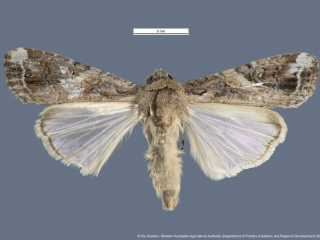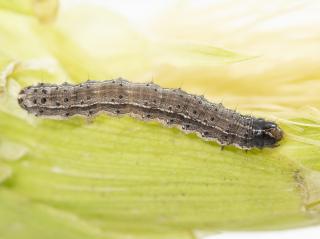Fall armyworm moths found at Northam
-
Northam
A male (and suspect female) fall armyworm (FAW) moth was recently found in a moth trap in a summer forage crop in the Shire of Northam. There was no noticeable damage in the crop and no caterpillars could be found. Its identity was confirmed by DPIRD entomologist Cameron Brumley.
This is the latest FAW finding in the WA grainbelt since a FAW moth was detected in a DPIRD trap near Geraldton in mid-July last year and moths and caterpillars near Gingin this year.
What does this mean for WA growers?
Growers and consultants are urged to continue being vigilant and checking for this new pest when monitoring cereal, canola and pulse crops for pests throughout the growing season.
FAW do not diapause (suspend development) during any stage. They live year-round in places where there are available hosts and favourable temperatures. The ideal range for development is 23-30ºC. The insect can continue to develop slowly below this range but do not survive year-round where temperatures fall below 9-12⁰C and where frosts occur.
Identifying fall armyworm caterpillars
Fall armyworm larvae look similar to other caterpillars already present in the grainbelt. When they are young, FAW larvae are a light green colour with a larger darker head. They have dark spots and short spines along the body. As they develop, they become darker and develop white lengthwise stripes. As they mature, FAW larvae can be quite variable in colour. Larger FAW larvae can be identified by the presence of an inverted ‘Y’ shape on the head. The pattern of the spots along the body is important and help in identification. .
It is important that growers and consultants are able to distinguish fall armyworm caterpillars from other common caterpillars that are similar in appearance. For example, budworm caterpillars that are commonly found in the grainbelt can appear in variable colours, similar to the FAW caterpillar, especially when the caterpillars are young (less than 25mm).
For more tips on identifying FAW refer to DPIRD’s:
- 2020 PestFax Issue 14 How to distinguish Fall armyworm caterpillars from other endemic caterpillars article
- Fall armyworm larval identification guide factsheet
- How to identify fall armyworm video.
What should you do if you suspect you have found fall armyworm?
If you find a caterpillar that you suspect to be FAW, please collect a sample. Place the caterpillar into boiling water for approximately five minutes, as this denatures enzyme activity. Then place the caterpillar into 70% ethanol or methylated spirits and contact DPIRD entomologist Dusty Severtson on +61 (0)427 196 656 to arrange for identification.
You can also take clear close-up photos of the caterpillar and plant damage and submit a report using the MyPestGuide Reporter app, or contact DPIRD’s Pest and Disease Information Service (PaDIS) by email or phone +61 (0)8 9368 3080. Samples may then be requested, as the only way to make a definitive identification for FAW is from examining a physical specimen under a microscope. DPIRD entomologists cannot make a definitive identification from images, but they do help to narrow it down and rule them out as other species.
Managing fall armyworm
Thresholds for fall armyworm in cereals and canola are not well-established. If FAW are found to be damaging crops, information about calculating thresholds, insecticide permits and integrated pest management options can be found at DPIRD’s Fall armyworm in Western Australia page.
New research indicates there may be variable levels of sensitivity to some insecticides between populations of FAW in different geographical areas of Australia. For more information, refer to GRDC’s Groundcover article Differences in insecticide sensitivity shown in fall armyworm .
For more information on FAW refer to:
- DPIRD’s Fall Armyworm in Western Australia page
- DPIRD’s Fall armyworm larval identification guide fact sheet
- GRDC’s Fall armyworm portal
For more information contact Dustin Severtson, Research scientist, Northam on +61(0)8 9690 2160 or +61 (0)427 196 656.
Article authors: Dusty Severtson (DPIRD Northam), Helen Spafford (DPIRD Kununurra) and Cindy Webster (DPIRD Narrogin).


